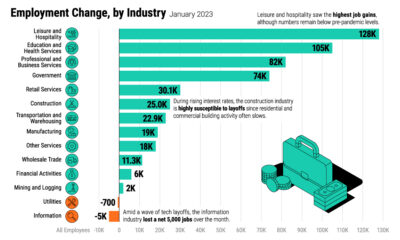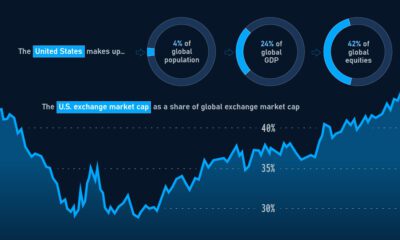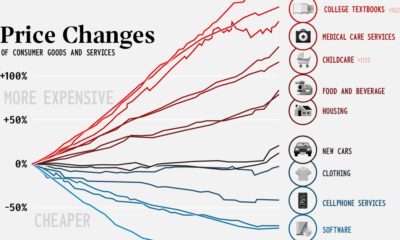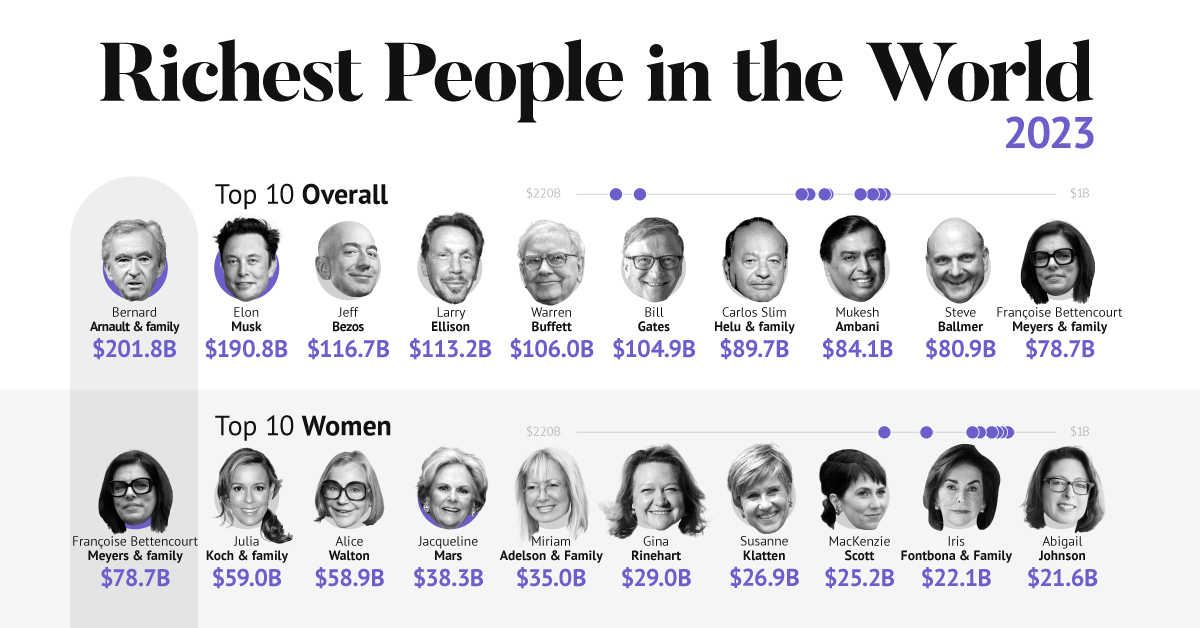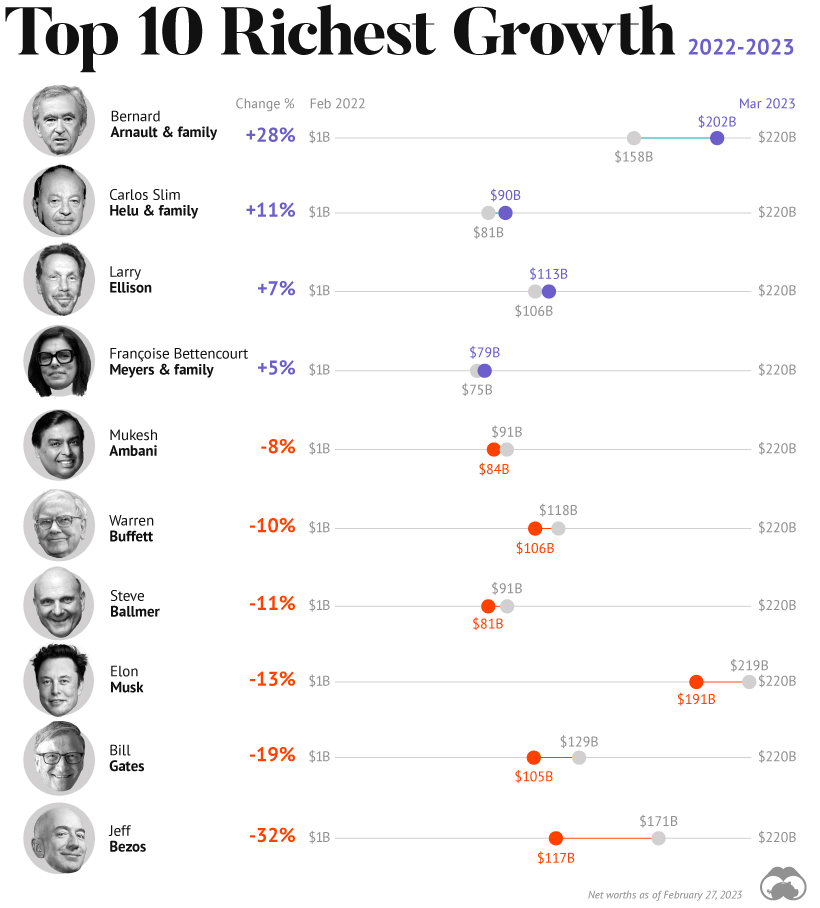While this quote was penned in 1789, his words still ring true today. U.S. taxation has changed over time, but it has always existed in some shape or form for over 250 years.
U.S. Taxation: 1765 to Today
In today’s infographic from New York Life Investments, we explore the history of U.S. taxation – from its colonial roots to its recent reform.
The modern American tax code has little resemblance to its early iterations. Over the last few centuries, Americans have battled against British taxation, faced sky-high tax rates to fund war efforts, and enjoyed tax cuts designed to boost economic growth.
A Timeline of U.S. Taxation
Today, total U.S. tax revenue exceeds $3.4 trillion. Below are some notable events that have shaped modern American taxation.
Colonial Roots: 1765 to 1783
1765 – Stamp Act In its first direct tax on the colonists, Britain places a tax on all paper – including ship’s papers, court documents, advertisements, and even playing cards. 1767 – Townshend Revenue Act Importation duties are placed on British products such as glass, paint, and tea. The taxes are expected to raise £40,000 annually, (£6,500,000 in 2018 GBP). As hostilities continue to bubble up, colonists argue for “No taxation without representation”. Although taxes are imposed on the colonists, they aren’t able to elect representatives to British parliament. 1770 – The Boston Massacre British troops occupy Boston to end the boycott on British goods. The March 5th Boston Massacre sees five colonists killed. By April, all Townshend duties are repealed except for the one on tea. 1773 – The Tea Act (May 10) Britain grants the struggling British East India Company a monopoly on tea in America. While no new taxes are imposed, this angers colonists as it is seen as a thinly veiled plan to gain colonial support for the Townshend tax while threatening local business. 1773 – The Boston Tea Party (December 16) Three ships arrive in Boston carrying British East India Company tea. Colonists refuse to allow the unloading of the tea, throwing all 342 chests of tea into Boston Harbour. 1775-1783 – The American Revolutionary War Growing tensions between Britain and the colonists erupt in a full-scale war. After eight long years, Britain officially recognizes the independence of the United States.
A Free Nation: 1787 to 1943
1787 – The U.S. Constitution Congress gains the “power to lay and collect taxes, duties, imposts, and excises.” The government primarily earns revenue from excise taxes and tariffs, including an “importation tax” on slaves. 1791-1794 – Whiskey Rebellion Alexander Hamilton, the nation’s first Secretary of Treasury, leads the implementation of a whiskey excise tax. In 1794, whiskey rebels destroy a tax inspector’s home. President Washington sends in troops and quells the rebellion. 1862 – The Nation’s First Income Tax To help pay for the Civil War, President Lincoln legislates the nation’s first income tax. 1913 – 16th Amendment As World War I looms the 16th amendment is ratified, allowing for taxation without allocation according to state populations. An income tax is permanently introduced for both individuals and corporations, and the first Form 1040 is created. 1918 – The Revenue Act Tax rates skyrocket to pay for World War I efforts. The top tax rate is 77%. 1935 – Social Security Act In light of the Great Depression, the Social Security Act introduces:
An old-age pension program Unemployment insurance Funding for health and welfare programs
To fund the programs, a 2% tax is shared equally by an employee and their employer. 1942 – The Revenue Act Described by President Roosevelt as “the greatest tax bill in American history”, the Act increases taxes and the numbers of citizens subject to income tax. Total personal and corporate income tax revenue more than doubles:
Modern Times: 1961 to 2018
1961 – Beginning of The Computer Age The National Computer Center at Martinsburg, West Virginia is formally dedicated to assisting the IRS in its shift to computer data processing. 1986 – Tax Reform Act The Tax Reform Act:
Lowers the top individual tax rate from 50% to 28% Increases taxes on capital gains from 20% to 28% Reduces corporate tax breaks
The revisions are designed to make the tax code simpler and fairer. 1992 – Electronic Filing Taxpayers who owe money are given the option to file electronically. 2001 – Economic Growth and Tax Relief Reconciliation Act President George W. Bush implements large tax cuts:
Creates a new lowest individual tax rate of 10% Reduces the top individual tax rate from 39.6% to 35% Doubles child tax credit from $500 to $1,000* (*From $700 to $1,400 in 2019 dollars)
2017 – Tax Cuts and Jobs Act President Trump signs off on reductions in tax rates, while some deductions are made more restrictive. For example, State and Local Taxes (SALT) deductions are capped at $10,000. Residents in high-tax states such as New York, New Jersey, California and Connecticut could see substantially higher tax bills.
The Future
U.S. taxation policy remains a contentious issue and shifts depending on who is in the White House. Investors need to stay informed on current legislation, so they can engage in proactive financial planning and minimize their tax obligations. on A lagging stock market dented these fortunes against high interest rates, energy shocks, and economic uncertainty. But some of the world’s billionaires have flourished in this environment, posting sky-high revenues in spite of inflationary pressures. With data from Forbes Real-Time Billionaires List, we feature a snapshot of the richest people in the world in 2023.
Luxury Mogul Takes Top Spot
The world’s richest person is France’s Bernard Arnault, the chief executive of LVMH.
With 75 brands, the luxury conglomerate owns Louis Vuitton, Christian Dior, and Tiffany. LVMH traces back to 1985, when Arnault cut his first major deal with the company by acquiring Christian Dior, a firm that was struggling with bankruptcy.
Fast-forward to today, and the company is seeing record profits despite challenging market conditions. Louis Vuitton, for instance, has doubled its sales in four years.
In the table below, we show the world’s 10 richest people with data as of February 27, 2023:
Elon Musk, the second-wealthiest person in the world has a net worth of $191 billion. In October, Musk took over Twitter in a $44 billion dollar deal, which has drawn criticism from investors. Many say it’s a distraction from Musk’s work with Tesla.
While Tesla shares have rebounded—after falling roughly 70% in 2022—Musk’s wealth still sits about 13% lower than in March of last year.
Third on the list is Jeff Bezos, followed by Larry Ellison. The latter of the two, who founded Oracle, owns 98% of the Hawaiian island of Lanai which he bought in 2012 for $300 million.
Fifth on the list is Warren Buffett. In his annual letter to shareholders, he discussed how Berkshire Hathaway reported record operating profits despite economic headwinds. The company outperformed the S&P 500 Index by about 22% in 2022.
How Fortunes Have Changed
Given multiple economic crosscurrents, billionaire wealth has diverged over the last year. Since March 2022, just four of the top 10 richest in the world have seen their wealth increase. Two of these are European magnates, while Carlos Slim Helu runs the largest telecom firm in Latin America. In fact, a decade ago Slim was the richest person on the planet. Overall, as the tech sector saw dismal returns over the year, the top 10 tech billionaires lost almost $500 billion in combined wealth.
Recent Shakeups in Asia
Perhaps the most striking news for the world’s richest centers around Gautam Adani, formerly the richest person in Asia. In January, Hindenburg Research, a short-selling firm, released a report claiming that the Adani Group engaged in stock manipulation and fraud. Specifically, the alleged the firm used offshore accounts to launder money, artificially boost share prices, and hide losses. The Adani Group, which owns India’s largest ports—along with ports in Australia, Sri Lanka, and Israel—lost $100 billion in value in the span of a few weeks. Interestingly, very few Indian mutual funds hold significant shares in Adani Group, signaling a lack of confidence across India’s market, which was also cited in Hindenburg’s report. As a result, Mukesh Ambani has climbed to Asia’s top spot, controlling a $84 billion empire that spans from oil and gas and renewable energy to telecom. His conglomerate, Reliance Industries is the largest company by market cap in India.

